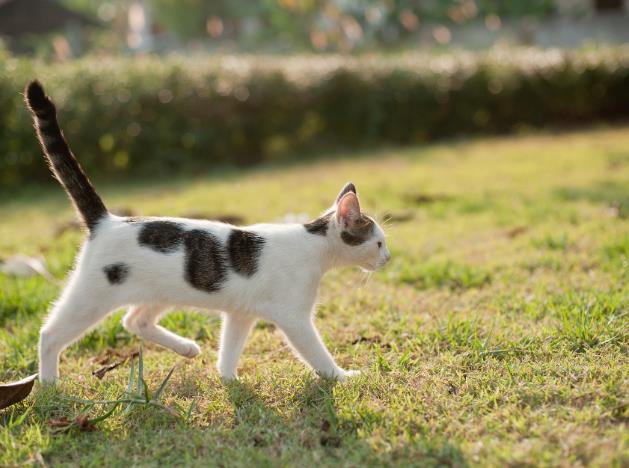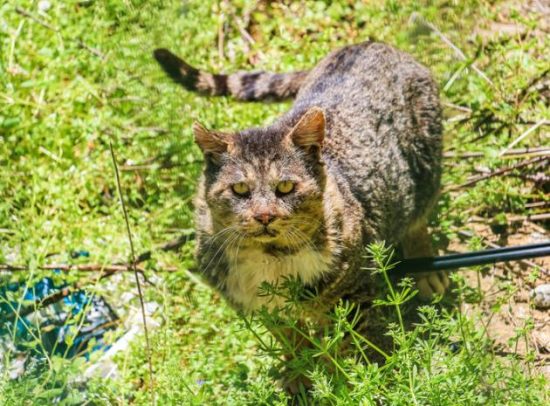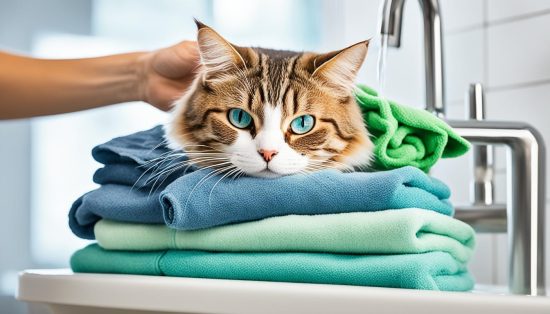How to Keep Cats Out of Your Yard: Effective Methods
Discover effective methods to keep unwanted feline visitors away from your yard using humane and pet-friendly solutions with our comprehensive guide on “how to keep cats out of your yard.”

Did you know that over 90 million households in the United States are home to at least one feline companion? While many cat owners cherish their furry friends, some homeowners find uninvited cats roaming their yards a nuisance. These felines can dig up your prize flowers, turn your landscape into a litter box, or even stress out your pets. This comprehensive guide will teach you effective, humane methods on how to keep cats out of your yard. From eliminating food sources to installing motion-activated sprinklers, we’ll cover 9 proven techniques to reclaim your outdoor space.
Key Takeaways
- Understand why cats may be attracted to your yard and use that knowledge to deter them.
- Implement humane methods to discourage cats from entering your property, such as eliminating food sources and blocking access to hiding spots.
- Utilize a combination of deterrents, including scent repellents, motion-activated sprinklers, and cat-proof fencing, for maximum effectiveness.
- Create a designated “home base” for cats in your neighborhood to draw them away from your own yard.
- Persist with your efforts. Effectively keeping cats out of your yard may take time and a multi-pronged approach.
Why Cats Might Visit Your Yard?

Cats may be attracted to your yard for various reasons, such as the availability of food sources, suitable hiding spots, or the presence of other stimulating features. Understanding what draws cats to your property is the first step in effectively deterring them. Cats may be drawn to your yard if they can access easy food sources, such as unsecured trash cans or outdoor pet bowls. They may also be attracted to areas that provide suitable hiding spots, like under decks or in crawl spaces. Additionally, the presence of features like bird feeders or birdbaths can pique a cat’s natural hunting instincts.
Humane Methods for Deterring Cats
As cherished companions to many and adept hunters in their own right, cats often wander into neighborhoods, bringing their curious nature and hunting instincts with them. While their presence can be charming, it may also pose challenges for homeowners seeking to protect their property or wildlife. Fortunately, deterring cats from specific areas or behaviors can be achieved through humane methods that prioritize their welfare while promoting coexistence. In this comprehensive guide, we explore four effective and compassionate strategies for deterring cats, emphasizing the importance of fostering a harmonious environment for both felines and humans.
Eliminate Food Sources
One of the most fundamental steps in deterring cats from unwanted areas is to remove enticing food sources. Outdoor cats, whether pets or strays, are attracted to locations where food is readily available. To discourage their presence, homeowners can take proactive measures to eliminate or secure potential food sources. This includes keeping outdoor garbage bins tightly sealed to prevent access, cleaning up fallen fruits or vegetables in gardens, and securing compost piles to prevent scavenging. Additionally, ensuring that pet food bowls are promptly emptied and stored indoors after feeding times can help minimize opportunities for outdoor cats to forage. By eliminating these food sources, homeowners can effectively discourage cats from frequenting their property without resorting to harmful or inhumane methods.
Secure Trash Cans

Trash cans are a common target for cats seeking food scraps or discarded items. To deter feline visitors, homeowners can employ strategies to secure their trash cans effectively. This may involve investing in sturdy, animal-proof trash cans with locking lids or adding additional deterrents such as bungee cords or heavy weights to prevent access. Alternatively, storing trash cans in enclosed areas such as garages or sheds until collection day can help minimize cat scavenging opportunities. By taking proactive steps to secure trash cans, homeowners can reduce the likelihood of attracting unwanted feline visitors while maintaining a tidy and hygienic outdoor environment.
Remove Pet Food Bowls
Leaving pet food bowls outdoors can inadvertently attract not only cats but also other wildlife species, leading to potential conflicts or disturbances. To deter cats from lingering around the property, homeowners should promptly remove pet food bowls after feeding times. This includes storing bowls indoors or in secure areas where cats cannot access them. Additionally, establishing designated feeding areas indoors or within enclosed spaces can help minimize the risk of attracting outdoor cats while ensuring that pets receive their meals in a safe and controlled environment. By removing pet food bowls from outdoor areas, homeowners can eliminate a significant attractant for cats and promote a more harmonious coexistence between pets and wildlife.
Limit Bird Feeders
While bird feeders can attract a variety of avian species, they may also inadvertently attract cats seeking to prey on birds or small mammals. To mitigate this risk, homeowners can take steps to strategically place or modify bird feeders to deter cats while still providing food for birds. This may involve positioning bird feeders away from potential hiding spots or elevated areas where cats can ambush unsuspecting prey. Additionally, installing baffles or other physical barriers around bird feeders can help prevent cats from accessing them while still allowing birds to feed freely. By taking proactive measures to limit access to bird feeders, homeowners can create a safer and more inviting environment for birds while reducing the risk of cat predation.
Block Access to Hiding Spots
Cats often seek out cozy, concealed areas to rest and evade detection, such as beneath decks or within crawl spaces. By strategically installing chicken wire or lattice in these potential hiding spots, you can effectively block their access and discourage felines from taking up residence in your yard.
Covering the openings under your deck or porch with chicken wire or a sturdy lattice can create a physical barrier that prevents cats from burrowing their way into these sheltered areas. This simple yet effective measure helps eliminate the cat-friendly hiding spots that may draw them to your property.
Check for Trapped Cats Before Blocking
Before sealing off any potential hiding spots, it’s crucial to thoroughly inspect the areas to ensure no cats or kittens are already trapped inside. Inadvertently blocking an entry point with a cat still present could lead to a distressing situation for the animal. Take the time to carefully check for any feline occupants before proceeding with your yard cat-proofing efforts.
When it comes to keeping cats out of your yard, scent repellents can be an effective solution. These products leverage the feline sense of smell to create an unpleasant environment that deters them from entering your outdoor space. There are several cat deterrents available on the market, such as PetSafe SSSCAT Spray and Nature’s Miracle Just for Cats Pet Block, that utilize specific scents cats find unpleasant. These commercial cat-proofing yard sprays can be strategically applied around the perimeter of your property or in areas where you’ve noticed frequent cat activity. In addition to commercial humane cat repellents, you can also use natural scents that cats find offensive to create a cat-resistant garden. Some effective options include citrus peels, coffee grounds, tea leaves, vinegar, pipe tobacco, and essential oils like lavender, citronella, lemongrass, or eucalyptus.
Plant Cat-Repelling Vegetation
Many plants have natural scents that can repel cats, including pennyroyal, rue, scaredy-cat plants, lavender, geraniums, citronella, and lemongrass. Strategically planting these around your yard can help discourage feline visitors. However, it’s important to note that some of these plants can be toxic if ingested by pets or humans, so use caution.
Make Lounging or Digging Areas Uncomfortable
To discourage cats from lounging or digging in specific areas of your yard, you can use various techniques to make those spots less appealing. These methods are designed to create an uncomfortable environment for felines without harming them.Placing plastic carpet runners with the spike side up in areas where cats like to lounge or dig can make those spots uncomfortable for them without causing harm. This deters cats from settling in or digging up the ground in those locations.
CatScat mats, which have long, flexible plastic spikes, can also be used to deter cats from certain areas of your yard. The spikes create an unpleasant sensation for cats, discouraging them from walking or lounging on the mats. Covering the ground in your garden with chicken wire or plastic bird netting can prevent cats from digging in those areas. The sharp or uneven texture of the materials makes it uncomfortable for cats to walk or dig in those spaces.
How to keep cats out of your yard?
Ultrasonic animal repellers can be an effective tool for keeping cats out of your yard. These devices emit high-frequency sounds that are unpleasant for cats and other wildlife, such as raccoons, opossums, and deer, but remain inaudible to human ears. Strategically placing these repellers around your property can help deter cats from entering your outdoor space.
Outdoor vs Indoor Use
It’s important to select models designed for outdoor use and larger pests when using ultrasonic repellents, as indoor devices may not be powerful enough to keep cats out of your yard effectively. Additionally, remember to turn off the device before letting your pets outside, as the high-frequency sound can also bother them.
Install Motion-Activated Sprinklers

Motion-activated sprinklers are designed to startle and deter cats (and other animals) by shooting out a burst of water when they enter the device’s detection range. Carefully place these motion-activated sprinklers around the perimeter of your property or in problem areas, and adjust the settings to ensure they only cover the desired locations.
Strategically positioning your motion-activated sprinklers is key to their effectiveness in keeping cats out of your yard. Experiment with different placements around your property, focusing on areas where you’ve noticed feline activity or potential entry points. Adjust the sensitivity and coverage settings to optimize the sprinklers’ ability to detect and deter cat deterrents.
In colder climates, motion-activated sprinklers may not be effective during the winter months, as the water in the hoses can freeze. It’s best to install these devices in the spring or summer when they will most effectively keep cats out of the garden before winter.
Use Cat-Proof Fencing

Regular fences may not be enough to keep climbing cats out of your yard. Slanted wire panels or chain link fencing installed along the top of a standard fence, angled outward, can create an effective barrier to deter cats from jumping or climbing over.
Incorporating slanted wire panels or angled chain link fencing at the top of your existing fence can make it much more difficult for cats to gain access to your yard. This cat-proofing technique creates a physical obstacle that discourages feline visitors from attempting to scale the barrier.
Another effective cat-resistant garden solution is to install rolling bars on top of an existing fence, such as the Oscillot cat fence roller system. When cats try to scale the fence, the rolling bars will spin, forcing them to jump back down and deterring further attempts to enter your yard.
Improve Home Base for Cats
If there are aspects of your property that are particularly appealing to cats, such as sunny spots or areas for them to get out of the weather, you can work with any cat caretakers in your neighborhood to provide these features in the yards where cats are welcome, rather than in your own yard. Offering perches and shelters in designated cat-friendly areas can give these feline visitors a comfortable place to rest and observe their surroundings, diverting their attention from your prized garden or landscaping.
Planting catnip and other cat-friendly plants in specific zones can lure cats away from your flower beds and vegetable garden, providing them with a more appropriate “home base” to enjoy. Setting up an outdoor litter box in a secluded area can give cats a designated spot to use, rather than your flower beds or vegetable garden. This can help prevent unwanted digging and cat waste in your yard.
Combine Multiple Methods
Often, a single deterrent method may not be enough to keep cats out of your yard effectively. To enhance your chances of success, it’s recommended to try a combination of the techniques discussed throughout this guide, such as using scent repellents, installing motion-activated sprinklers, and implementing cat-proof fencing.
By layering various deterrents, you create a more comprehensive and formidable barrier against feline intruders. For instance, pairing citrus-based scent repellents with the unexpected startling effect of motion-activated sprinklers can make your yard significantly less appealing to neighboring cats. Additionally, strategically placing cat-proof fencing along with these other methods can further discourage cats from attempting to enter your outdoor space.
Remember, consistency and vigilance are key when employing a multi-pronged approach. Regularly reapplying scent repellents, checking the functionality of your motion sensors, and maintaining the integrity of your cat-proof barriers will ensure your deterrence efforts remain effective over time.
| Deterrent Method | Key Benefits | Potential Drawbacks |
|---|---|---|
| Scent Repellents |
|
|
| Motion-Activated Sprinklers |
|
|
| Cat-Proof Fencing |
|
|
Conclusion
Keeping cats out of your yard can be challenging, but with the right combination of humane deterrents, you can reclaim your outdoor space without harming the felines. By understanding what draws cats to your property and using a variety of proven techniques, you can create a cat-free yard that you and your family can enjoy.
From eliminating food sources and blocking access to hiding spots, to using scent repellents and strategically planting cat-repelling vegetation, the methods outlined in this guide provide a comprehensive approach to deterring unwanted feline visitors. By implementing a multi-faceted strategy, you’ll be better equipped to keep your yard free from unwanted cat activity.
Remember, the key is to use a combination of these humane techniques and to be persistent in your efforts. With patience and diligence, you can create a welcoming outdoor space that is free from the paw prints and disruptions of neighborhood cats, allowing you and your family to appreciate the beauty and serenity of your own backyard fully.
Editor’s Choice:
FAQs on Keeping the Cats Out of Your Yard
What are some reasons cats may be attracted to my yard?
Cats may be attracted to your yard due to the availability of food sources, suitable hiding spots, or the presence of other stimulating features.
What are some effective and humane methods to keep cats out of my yard?
Effective and humane methods to keep cats out of your yard include eliminating food sources, blocking access to hiding spots, using scent repellents, planting cat-repelling vegetation, making lounging or digging areas uncomfortable, installing ultrasonic animal repellers, and using motion-activated sprinklers.
How can I secure my trash cans to prevent cats from accessing them?
Always keep trash cans covered, and consider securing the lids with bungee cords to prevent cats from getting inside.
What should I do if I have bird feeders or birdbaths in my yard?
Consider temporarily removing bird feeders or birdbaths in your yard, as they may be luring cats who are hunting for prey.
How can I block access to potential hiding spots for cats in my yard?
Install chicken wire or lattice to block access to warm, dark spaces where cats may try to hide, such as under decks or in crawl spaces. Be sure to inspect these areas first to ensure no cats or kittens are already trapped inside before sealing them off.
What types of scent repellents can I use to deter cats from my yard?
You can use commercial repellent sprays or natural scents that cats find unpleasant, such as citrus peels, coffee grounds, tea leaves, vinegar, pipe tobacco, and essential oils like lavender, citronella, lemongrass, or eucalyptus. However, these scents will fade over time, so you’ll need to reapply them about once a week.
What plants can I use to repel cats from my yard?
Plants with natural scents that can repel cats include pennyroyal, rue, scaredy-cat plant, lavender, geraniums, citronella, and lemongrass. However, some of these plants can be toxic if ingested by pets or humans, so use caution.
How can I make areas of my yard uncomfortable for cats to lounge or dig in?
You can place plastic carpet runners with the spike side up, use CatScat mats with flexible plastic spikes, cover the ground with chicken wire or plastic bird netting, apply a sharp or rough mulch like crushed eggshells or pine cone pieces, or stick branches, garden stakes, or forks into the soil.
How do ultrasonic animal repellers work to keep cats out of my yard?
Ultrasonic animal repellers emit high-frequency sounds that are unpleasant for cats and other wildlife, such as raccoons, opossums, and deer, but inaudible to humans. Be sure to purchase models designed for outdoor use and larger pests, and remember to turn them off before letting your own pets outside.
What should I consider when using motion-activated sprinklers to deter cats?
Motion-activated sprinklers are designed to startle and deter cats by shooting out a burst of water when they enter the device’s detection range. Carefully place these sprinklers around the perimeter of your property or in problem areas, and adjust the settings to ensure they only cover the desired locations. In colder climates, these sprinklers may not be effective during the winter months, as the water in the hoses can freeze.
How can I make my fence more effective at keeping cats out of my yard?
Regular fences may not be enough to keep climbing cats out of your yard. You can install slanted wire panels or chain link fencing along the top of a standard fence, angled outward, to create an effective barrier. Another option is to install rolling bars on top of an existing fence, such as the Oscillot cat fence roller system, which will spin and force cats to jump back down.
How can I provide a more suitable “home base” for cats in my neighborhood?
If there are aspects of your property that are particularly appealing to cats, such as sunny spots or areas for them to get out of the weather, you can work with any cat caretakers in your neighborhood to provide these features in the yards where cats are welcome, rather than in your own yard. You can also plant catnip and other cat-friendly plants in designated areas or set up an outdoor litter box in a secluded spot to give cats a designated spot to use.
Should I use a combination of methods to keep cats out of my yard?
Often, a single deterrent method may not be enough to keep cats out of your yard. Trying a combination of techniques, such as using scent repellents, motion-activated sprinklers, and cat-proof fencing, can be more effective at discouraging feline visitors.






